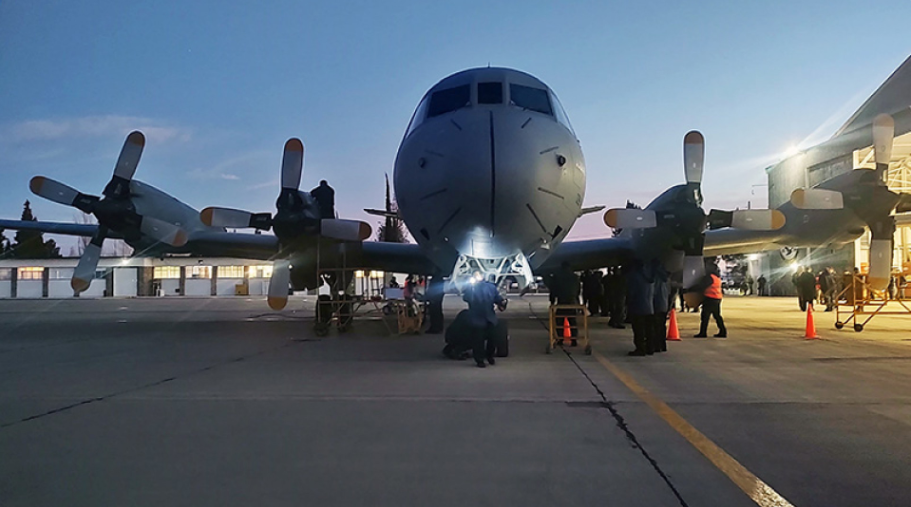Este lunes a la 18 y 20 aterrizó en Trelew el primero de los cuatro aviones P-3C Orion que adquirió el país tras varios años de negociaciones. Fueron adquiridos a la Armada del Reino de Noruega y servirán para robustecer el patrullaje de la Armada Argentina en el Atlántico Sur.
Se trata de un avión cuatri-turbo-helice matriculado 6-P-57 que partió del aeropuerto Keystone Heights, Florida, donde se completó la puesta en servicio. La adquisición se efectuó a través del Proyecto de Inversión Pública Nacional, con el objeto de “Mejorar las capacidades operativas y logísticas de las aeronaves de búsqueda y exploración del Comando de la Aviación Naval”.

Este primer P3-C Orion cuya matrícula es 163299, será rematriculado nacionalmente como 6-P-57, y su asiento estará en la actual Escuadrilla Aeronaval de Exploración perteneciente a la Fuerza Aeronaval N°3.
La ceremonia de recepción se llevará a cabo a mediados de septiembre en la Base Aérea Militar Aeroparque de la Ciudad Autónoma de Buenos Aires, la cual será presidida por el Ministro de Defensa, Luis Alfonso Petri, acompañado por el Jefe del Estado Mayor General de la Armada, Vicealmirante Carlos María Allievi. Asimismo, se prevé la participación de los Embajadores del Reino de Noruega y de los Estados Unidos de Norteamérica en la República Argentina; autoridades ministeriales del Reino de Noruega; y el Jefe del Estado Mayor Conjunto las Fuerzas Armadas, entre otras autoridades e invitados especiales.
La aeronave de exploración P-3 Orion versión C, otorga la capacidad de exploración de largo alcance, como así también el control y vigilancia de los espacios y áreas marítimas de responsabilidad e interés nacional.

Contribuye al cumplimiento de las obligaciones internacionales delegadas por el Estado Nacional en la Armada Argentina, por Ley N° 22.445, como Autoridad de Aplicación del convenio internacional sobre Búsqueda y Salvamento Marítimo, Fluvial y Lacustre (salvaguarda de la vida humana en el mar en la zona de responsabilidad SAR de 16.200.000 km²), y sobre el área marítima adyacente, representando este compromiso una importante obligación y esfuerzo de presencia de la Armada Argentina, en estrecha coordinación con otros Estados debido a nuestra ubicación geográfica.
También contribuye a ejercer, preservar y proteger derechos de soberanía argentina en la Zona Económica Exclusiva (ZEE) y sobre los demás espacios marítimos y fluviales de jurisdicción nacional, de vital importancia en cuanto a la necesidad de mantener una presencia permanente que permite, a su vez, brindar una alerta estratégica a la Nación para los fines de exploración, explotación, conservación y administración de los recursos naturales, tanto vivos como no vivos, y las líneas de comunicación marítimas, con especial interés en áreas focales de aproximación a nuestro país.
La incorporación de esta aeronave de ala fija, permite sostener e incrementar los estándares de seguridad aérea y de capacitación del personal de la Escuadrilla Aeronaval de Exploración, en lo relativo a Búsqueda y Rescate (Search and Rescue – SAR), operaciones de exploración, guerra antisuperficie y guerra antisubmarina, ayuda humanitaria, y apoyo a la comunidad en todo tipo de escenarios.
Simultáneamente, responde a las necesidades de adiestramiento del Poder Naval Integrado y mejora las capacidades del binomio aeronave – buque, al extender la búsqueda más allá del horizonte, aumentar la probabilidad de detección, reducir tiempos en la exploración de las áreas marítimas, y materializar la presencia de la Armada Argentina en una zona de alto interés nacional como la Antártida Argentina.
Las cuatro aeronaves, tres P-3C y un P-3N de sostén logístico móvil, tienen aplicado un programa de extensión de vida de servicio denominado ASLEP (Aicraft Service Life Extension Program), consistente en el reemplazo completo de las alas, lo que les permite disponer, en promedio, un remanente individual de 17.000 horas de vuelo, lo cual representa un tiempo de empleo de al menos 15 años. Además, la compra incluye los accesorios y repuestos, bancos de prueba y componentes de las aeronaves.
Características de los aviones
El Orión fue desarrollado a finales de los años 1950 por la compañía estadounidense Lockheed Martin. Fue concebido como un avión de guerra antisubmarina de peso medio, con alas grandes, rectas y extendidas para una mejor performance de vuelo a baja altitud y velocidad.

Cuenta con un tren de aterrizaje alto y reforzado en forma de triciclo. Dispone de cuatro motores turbohélice Allison T-56-A-14 (4.600 HP cada uno), tiene una longitud de 35,57 metros, una altura de 10,27 metros y una envergadura de 30,38 metros.
Su extenso radio de acción de 1.500 millas náuticas (2.780 km), sumado a su autonomía de 12 horas de vuelo, permiten cubrir sin inconvenientes el litoral marítimo argentino, plataforma continental y la Antártida, permitiendo la permanencia en una zona o área determinada por períodos prolongados.
Una de las principales características de este tipo de aeronaves de exploración de largo alcance es su versatilidad y posibilidad de efectuar diferentes misiones, desde patrullado y control de espacios marítimos y búsqueda SAR, como así también vuelos antisubmarinos.
Su aptitud para volar en todo tipo de clima, permite la operación desde cualquier base y aeropuerto del litoral marítimo del país, lo que facilita su presencia en un área determinada en un período de tiempo relativamente corto, fundamental para una búsqueda SAR.
Su capacidad de portar diferentes sensores de búsqueda, como radar de apertura sintética, sistemas de cámaras visuales e infrarrojas, procesadores acústicos para la detección subácua, detector de anomalías magnéticas y sistema de identificación automática de buques, asociados a sus múltiples sistemas de comunicaciones, permiten la recolección, procesamiento y transmisión de datos en tiempo real.
Asimismo, posee una gran capacidad para portar variedad de elementos utilizados para búsqueda y rescate SAR como bengalas, línea de mar para náufragos, como también los necesarios para la acción antisubmarina y antisuperficie.
Fuentes:
Diario Jornada
Argentina.gob.ar






